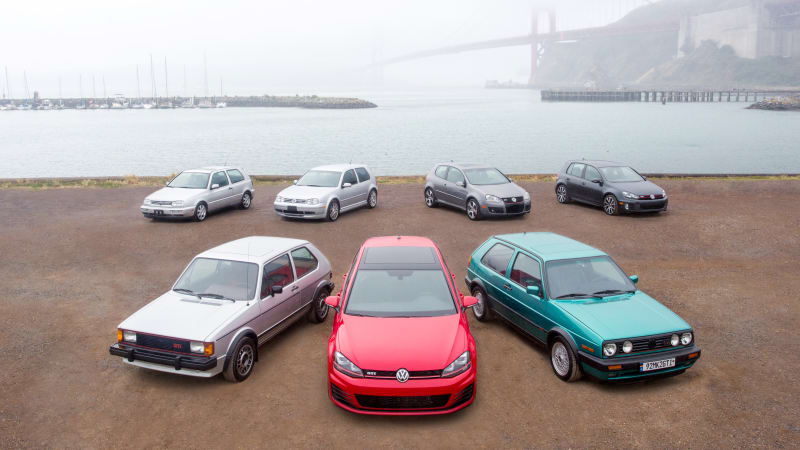 20 million within 16 years of production
20 million within 16 years of production
June 1974: Golf model debut
Self-supporting five-door body, front drive with transversely located, liquid cooled, four-cylinder engine. Front suspension with front wheel shock absorbers, rear suspension with linked wishbones. Golf with motor 1,1 liter of power 37 kW (50 KM) achieved 140 km / h, and with the engine
1,5 liter of power 70 KM even 160 km / h. After the end of the production of the "Beetle", the VW concern relies on the front-wheel drive.
June 1976: Market launch of the engine version of the Golf GTI 1,6 liter and petrol injection, with power 81 kW (110 KM) and maximum speed 181 km / h.
September 1976: Golf Diesel
The premiere of the car with light, 1.5 liter diesel engine.
March 1979: Golf Convertible
The open car, based on the Golf I, remains 14 years in production and with numbers 388 522 copies beats the world record for convertibles sales.
August 1983: Golf II
A wider track and a more spacious boot. The new suspension with longitudinal coupled wishbones improves driving characteristics. A choice of engines from 1,3 do 1,8 liter, including Turbodiesel.
March 1986: sixteen-valve engine
Golf 16V with an engine of power 102 kW (129 KM) reaching speed 210 km / h. Version GTI
1 16V were the first cars of this model to be equipped with regulated catalytic converters.
April 1986: Golf with four-wheel drive
The Visco clutch on the Golf Syncro connects the front and rear axles. The Rally Golf G60 with four-wheel drive and compressor has a powerful engine 118 kW (160 KM). Limited version with four-valve engine and power 210 KM, is the most powerful in the Golf family.
January 1990: in diesel engines, charge air cooling and the first oxidation catalysts were introduced.
August 1991: Golf III
The new generation of Golf has oval headlights and streamlined body lines. After installation in August 1992 driver and passenger airbags, this little limousine has the best safety parameters.
November 1991: The Golf VR6 is the first six-cylinder car in its class. The transverse V-engine has six cylinders with an angle of just 15 ".
February 1993: The new generation Golf Convertible.
September 1993: Golf Variant
June 1996: second version of the TDI engine (torque 235 N-m, moc 81 kW /110 KM).
August 1997: Golf IV
The fully galvanized body made it possible to provide a 12-year warranty on the perforation of the body sheets. Two new aluminum engines were used 1,4 i 1,6 liter and engine 1,8 liter with five valves per cylinder. Three types of direct injection diesel engines cover the power range from 50 kW (68 KM) do 81 kW (110 KM).
Beginning 1998: new convertible based on the Golf IV.
July 1998: new version of the Golf with four-wheel drive (4Motion) with electronically controlled Haldex clutch as well as ABS and ESP systems.
Maj 1999: the new Golf Variant. Rich equipment and many additional options were used, m.in. storing the position of electrically adjustable seats, satellite navigation system and lsofix child seat.
Lato 1999: diesel engines with unit injectors were used.
September 2000: The 20 millionth Golf leaves the plant in Wolfsburg. This compact car has become a benchmark in its class to be followed by other manufacturers.
September 2003: Golf V
Together 72 varieties
After counting all versions of Volkswagen Golf and Bora, it turns out. that is theirs 72. It is a fact, that the differences between some of them are not too great. According to the criteria of the type and power of the engine, the method of transmission and the type of gearbox (mechanical or automatic) is 20 Golf versions, 13 Golf Variant i 6 Cabrio. It is appropriate 18 version of Bora and 12 Bory Variant. There is a warranty for all models 12 months with no mileage limit, 3 years for varnish, 12 years for perforation of the body and assistance (guarantee of mobility), however, there is an exception: for convertibles there is only 6 years of warranty against perforation of the body.
Caring for the image of the model at Volkswagen
When in a year 1974 the Golf was introduced to the market, it was supposed to refer to the successes of the legendary "hunchback”. the first Golf model was already in place
in the concept of a modern compact car. This concept has worked well over the years and has basically not changed to this day: front-wheel drive with a transversely positioned engine at the front, independent suspension of the front wheels, rear suspension with linked wishbones and a combilimus chassis
The body line characteristic of the Golf has been retained. lego fluid forms determine the visual face of this car. The fourth generation emphasizes even more clearly, than when switching from Golf II to Golf III in a year 1991, that Golf remains Golf. Driving comfort, the wealth of equipment and safety standards have been improved. The fourth generation differs from the previous ones with a fully galvanized body, which significantly increases the durability of the car.
In the summer 1998 In the year, sales of the aforementioned model with all-wheel drive began (4Motion) with several motors to choose from. Since May 1999 In the year, cars are equipped with "intelligent” service mileage indicator. Electronic Stability Program ESP from September 1999 is part of the standard equipment.